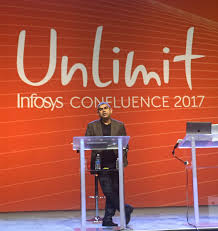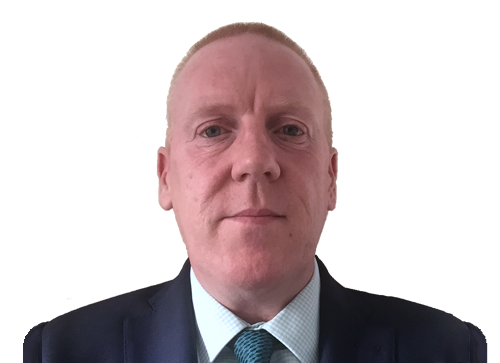posted on May 27, 2017 by Rachael Stormonth

NelsonHall recently attended the Infosys Confluence customer event. Last year the theme was covered in the interlinked motifs of Automation, Innovation, and Education (see here). This year, the theme evolved to ‘Unlimit’, which on the surface is more outward facing. We were not looking so much for an update on developments at Infosys over the last year (we cover these in our Quarterly Updates and Key Vendor Assessments on Infosys) as for updates on, among other things:
- Talent development in the services business/onshore U.S. hiring
- Developments in the products business, including with Nia
- New approaches to delivering innovation on behalf of clients.
This blog looks briefly at each.
The talent model
Onshore U.S. hiring: April’s NelsonHall QU on Infosys, covering its Q4 FY17 (see here), mentioned plans to increase onshore U.S. hiring: Infosys intends to hire 10k local employees over the next two years, and is setting up four development centers, the first in Indianapolis.
The intention is to co-locate innovation hubs in each of these delivery centers. While this makes sense from an internal perspective, we are surprised that there are no plans to set up small innovation showcase studies in key locations such as NYC that are closer to key clients.
Out of the 2,000 hiring plans for the Indianapolis center in FY18, Infosys has already hired around 800, of whom ~300 are campus hires. Infosys intends to leverage the local university system to do much of the initial training - last year its U.S. new hires had to travel to Mysore for training, and that is clearly not a realistic option as the U.S. delivery capability scales. Infosys will benefit from a major incentive package from the Indiana Economic Development Board, which will offset the investment required (around $8.7m) to set up a new facility.
Is this solely a defensive move in response to increased protectionism? Well, not quite: we noted in a former blog over a year ago that Infosys was intending to increase onshore recruitment at graduate level. It is of course also about being seen to be closer to the client in engagements that center on helping them in their digital transformation.
As well as grad recruitment, Infosys is also interested in personnel transfers from clients as part of outsourcing deals - what it somewhat clumsily calls “talent refactoring” - the type of transaction that other vendors have been doing for many years but one that has now gone out of favor with many. While this is one way of scaling up a local talent pool quickly, it also means an older, more expensive workforce (often with pension obligations) that will also need retraining in new technologies. Furthermore, Infosys has little experience in this.
There appears to have been solid progress in cultural transformation at the grass roots level through initiatives such as Zero Distance and Zero Bench. The latter has been a particularly innovative way to speed up development and experience for people on the bench and has also led to some useful s/w development activity. There has also been some level of delayering, with the focus for career development being on content leadership rather than on management advancement through span of control.
Putting all the software units under one head to drive Products business strategy and accelerate development
In our latest QU on Infosys, we noted two recent hires to its Products units:
- New CEO of the EdgeVerve subsidiary, Pervinder Johar (formerly CEO of Steelwedge Software. He is tasked with developing a channel route-to-market to be able to sell the software to a larger client base
- New leadership at Panaya, Jake Klein, whose key remit is to go after higher value opportunities.
These appointments follow that last year of Sudhir Jha (ex Google) as Head of Product Management and Strategy, and now also overseeing Nia. Like Johar, he is based in Silicon Valley.
Although his title at Confluence remains Head of EdgeVerve, it now appears that Pervinder Johar’s responsibility spans all of Infosys’ software units:
- EdgeVerve, which itself comprises two units:
- Edge: when first set up as a subsidiary three years ago, the purpose was to collect software from Infosys projects which had repeatable uses and productize those assets. These assets form the core of the Edge suite of software assets, now overseen by Andy Dey (ex SAP)
- Finacle: last year, its software and development assets were transferred to the EdgeVerve subsidiary, increasing its headcount from 650 to 6,500 at a stroke - Nia (formerly MANA), we will discuss below
- Skava, the customer loyalty management s/w acquired two years ago
- Panaya, acquired last year
All in all, there has been a series of external hires for Infosys’ products businesses in the last two years, as Sikka looks to accelerate growth: last quarter these units contributed 5.5% of total revenues, a level that has not changed significantly, in spite of acquisitions such as Panaya and Skava.
The Products business is currently undertaking a product strategy, and development coordination & creation exercise, which started last month. The main goals include to:
- Create a software business strategy and development roadmap
- Rationalize development to eliminate duplication of effort, facilitate asset reuse, and coordinate interoperability of broad functionality
- Rationalize its organizational structure, while retaining independence of units where appropriate
- Identify cross-sell opportunities.
Development centers for (also leadership of) these units are located across three continents:
- Edge and Finacle products: Bangalore and Pune
- Nia: San Francisco Bay area and Bangalore
- Skava: Bay area and Coimbatore
- Panaya: Israel
Co-ordination is thus not going to be straightforward, although the unit leaders are meeting weekly until the end of June. The exercise is consuming a lot of exec time, including their entire seven days prior to Confluence, so this is evidently a very high priority.
There is a clear ambition to drive third-party commercialization of Infosys software assets. This will require building a channel network, including other SIs, something which would be much easier if it had more of an arm’s length relationship from Infosys. We think there will be other developments in Infosys Products business in the near future, and not just an ongoing acceleration in product development that we have noted recently.
Recent product development announcements have included those of:
- A blockchain-based solution from Finacle
- OECloud (Open Enterprise Cloud) an open source framework for rapid development of cloud-native enterprise applications, originally developed for EdgeVerve
- From Panaya, a SAP testing tool launched earlier this month, then, announced at Confluence, a new cloud-based ALM platform Panaya Release Dynamix (RDx), expanding the Panaya suite beyond tools that support work on ERP environments to ones that enable agile development environments
Looking under the hood of Nia
In a session with Vishal Sikka called “Under the Hood of AI”, he revealed that there were now 160 use cases for elements in the Nia platform: an impressive number, in our opinion. While the early use cases were for IT, the more recent growth has been in the number of business use cases.
How Infosys could potentially use Nia:
- To improve internal service delivery within its IT infrastructure and applications businesses, what Infosys has for some time referred to as “renew the core”
- Within its consulting and SI units to help clients improve their business processes
- By combining the consulting capability with its BPS domain expertise to pre-build new digital-first business process models and then go to market with a managed services wrapper around these.
The first of these currently appears to be the primary focus. It is essentially a journey of automation being pursued by all services providers, and as such we question to what extent it will be a major differentiator in the long term.
The second of these requires strong consulting and industry domain capabilities in the GTM: and this does not appear to be a major focus for Infosys. In this respect, Infosys appears to be plowing a different furrow from many peers who are focusing on enhancing these capabilities.
However, there was a AI workshop on both Day 2 and Day 3 which were extremely well attended by clients. In these workshops, people identified, for their own organization, key areas for the application of AI, also the potential obstacles to implementing these (e.g. feasibility and change management). These workshops could, potentially, create significant new opportunities for Infosys downstream, providing their Products business links with the C&SI business.
So, let’s look at the third potential type of opportunity in leveraging Nia. We think this is the area where Infosys has the potential to come up with completely new software-led managed services offerings that could support clients in the kind of paradigm-shift innovation (business model and operational) that many organizations are now starting to ask for. But it would also make the BPS business more central to Infosys – and here we feel the current drive from the top is to focus on elimination of manual effort in existing business processes rather than on innovative process models that involve platforms (cloud-based) as well as analytics and AI and RPA. As such, we think this is an opportunity that Infosys is missing/choosing to ignore. There is a current drive to develop propositions to clients to help them progress from Walk to Crawl to Run to Fly (with the emphasis, of course, being on Fly proposals), but the thinking again does appear to be Technology first, Business Outcome second.


